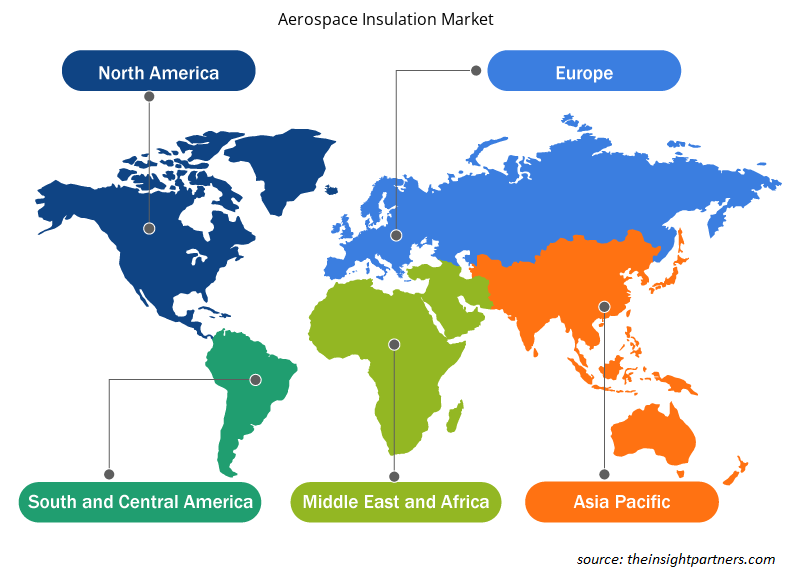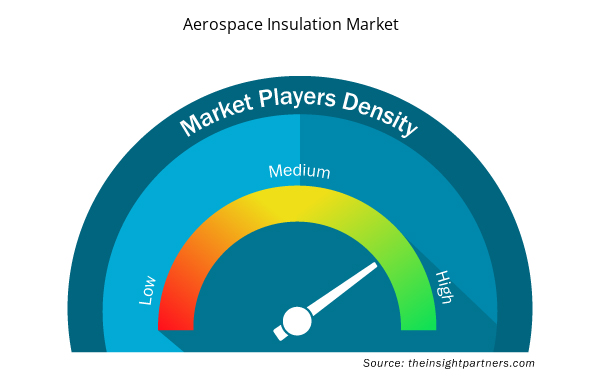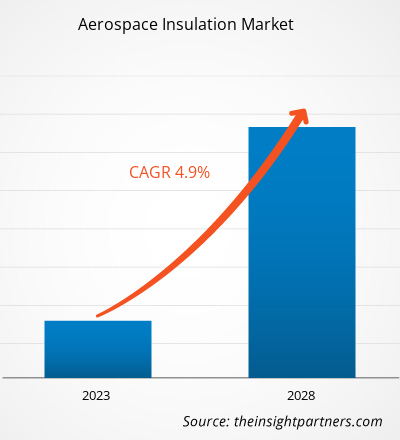Der Markt für Luft- und Raumfahrtisolierungen soll von 5.731,28 Millionen US-Dollar im Jahr 2022 auf 7.633,23 Millionen US-Dollar im Jahr 2028 wachsen; von 2022 bis 2028 wird mit einer durchschnittlichen jährlichen Wachstumsrate von 4,9 % gerechnet.
Unter Luft- und Raumfahrtisolierung versteht man das Material, das in Flugzeugen installiert wird, um die Sicherheit und den Komfort zu verbessern. Die Funktionen des Flugzeugs unter schwierigen klimatischen Bedingungen müssen bestimmten grundlegenden Betriebsabläufen sowie Sicherheitsmaßnahmen in Bezug auf Gewicht, Temperatur und Gesamtleistung entsprechen. Aufgrund von Vorteilen wie geringeren Vibrationen und Geräuschpegeln während der Flugstunden wächst die Nachfrage nach Isoliermaterialien rasant. Die zunehmende Verwendung von Verbundwerkstoffen in Verkehrsflugzeugen dürfte die Entwicklung verschiedener Flugzeugstrukturen vorantreiben, was zu einem erheblichen Branchenpotenzial führt. Die steigende Nachfrage nach leichten Isoliermaterialien und Verbundwerkstoffen in der Verkehrsflugzeug- und Businessjet-Industrie zur Reduzierung des Kabinenlärms wird den Markt in den nächsten Jahren wahrscheinlich antreiben.
Die Isolierung von Flugzeugen spielt eine entscheidende Rolle beim Schutz von Besatzung und Passagieren vor Generatorlärm und eisigen Temperaturen in höheren Lagen. Die steigende Nachfrage nach leichten, treibstoffeffizienten Flugzeugen der neuen Generation und der zunehmenden Bedeutung der Emissionsreduzierung dürfte die Flugzeugproduktion steigern. Die bedeutende Entwicklung der Reisebranche in den Schwellenmärkten und die steigende Zahl der Passagiere im internationalen und inländischen Reiseverkehr sind die Hauptfaktoren, die den globalen Markt für Isolierungen in der Luft- und Raumfahrt antreiben . Laut der International Air Transport Association (IATA) beispielsweise stieg die Gesamtnachfrage nach Flugreisen im April 2022 im Vergleich zum April 2021 um 78,7 %.
Passen Sie diesen Bericht Ihren Anforderungen an
Sie erhalten kostenlos individuelle Anpassungen an jedem Bericht, einschließlich Teilen dieses Berichts oder einer Analyse auf Länderebene, eines Excel-Datenpakets sowie tolle Angebote und Rabatte für Start-ups und Universitäten.
- Holen Sie sich die wichtigsten Markttrends aus diesem Bericht.Dieses KOSTENLOSE Beispiel umfasst eine Datenanalyse von Markttrends bis hin zu Schätzungen und Prognosen.
Laut der Federal Aviation Administration (FAA) müssen alle Verkehrsflugzeuge über eine Wärme- und Schalldämmung verfügen. Diese Dämmung sorgt dafür, dass der Komfort der Passagiere nicht durch Temperaturschwankungen im Außenbereich beeinträchtigt wird und dass übermäßiger Lärm des Flugzeugs die Kommunikation nicht stört. Derart strenge Vorschriften ermutigen Flugzeughersteller, Dämmmaterial in Flugzeugen zu verwenden, was den Markt für Dämmstoffe in der Luft- und Raumfahrt ankurbelt.
Viele Hersteller von Dämmstoffen für die Luft- und Raumfahrt wie Zotefoams entwickeln leichte Baumaterialien für die Luft- und Raumfahrt, um die Treibstoffeffizienz und Nachhaltigkeit zu steigern. Wärme- und Schalldämmung schützt in den meisten Flugzeugen vor übermäßigem Lärm und übermäßiger Temperatur. Wärme- und Schalldämmung besteht aus einer einzigartigen Hochleistungsfaser, die in einer für Flugzeuge geeigneten Kunststoffhülle eingeschlossen ist, die die Dämmstoffe zusammenhält und gleichzeitig als Feuchtigkeitsbarriere fungiert.
Markteinblicke
Wachstum im Luftverkehrssektor beflügelt den Markt für Luft- und Raumfahrtisolierungen
Der Luftverkehrssektor wächst schnell und dies wird sich in den nächsten Jahren voraussichtlich fortsetzen. Nach Schätzungen der International Air Transport Association (IATA) wird die Nachfrage nach Luftverkehr bis 2036 voraussichtlich um durchschnittlich 4,3 % pro Jahr steigen. Wenn dieses Wachstum bis 2036 erreicht wird, wird die Luftverkehrsbranche im Prognosezeitraum voraussichtlich 15,5 Millionen direkte Arbeitsplätze und 1,5 Billionen US-Dollar BIP zur Weltwirtschaft beitragen. Ein derart starkes Wachstum der Luftverkehrsnachfrage wird zu einer höheren Nachfrage nach Flugzeugen führen. Luft- und Raumfahrtisolierung wird in Flugzeugen verwendet, um den Komfort und die Sicherheit von Flugzeugen und Passagieren zu erhöhen, was den Markt für Luft- und Raumfahrtisolierung im Prognosezeitraum voraussichtlich ankurbeln wird. Darüber hinaus sinken die Kosten für Verbundwerkstoffe kontinuierlich, sodass Flugzeughersteller Verbundwerkstoffe für die Luft- und Raumfahrtisolierung verwenden können. Aufgrund dieser Faktoren wird der Markt im Prognosezeitraum daher schnell florieren.
Produktinformationen
Basierend auf dem Produkt ist der Markt für Luft- und Raumfahrtisolierungen in Wärmedämmung, Schalldämmung, elektrische Isolierung und Schwingungsisolierung unterteilt. Im Jahr 2021 dominierte das Segment Wärmedämmung den Markt und wird im Prognosezeitraum voraussichtlich mit einer schnelleren CAGR wachsen. Verstärkte Forschungs- und Entwicklungsaktivitäten zur Herstellung fortschrittlicher, leichter und nachhaltiger Wärmedämmstoffe kurbeln das Wachstum des Wärmedämmungssegments im Prognosezeitraum an.
3M; TransDigm Group Incorporated; Triumph Group, Inc.; Johns Manville; Morgan Advanced Materials Plc; Polymer Technologies Inc.; Duracote Corporation; Rogers Corporation; DuPont; und BASF SE sind die wichtigsten Akteure auf dem Markt für Luft- und Raumfahrtisolierungen. Die führenden Akteure verfolgen verschiedene Strategien, wie Fusionen und Übernahmen sowie Produkteinführungen, um ihre geografische Präsenz und Kundenbasis zu erweitern.
Regionale Einblicke in den Markt für Luft- und Raumfahrtisolierungen
Die regionalen Trends und Faktoren, die den Markt für Luft- und Raumfahrtisolierungen im Prognosezeitraum beeinflussen, wurden von den Analysten von Insight Partners ausführlich erläutert. In diesem Abschnitt werden auch die Marktsegmente und die Geografie für Luft- und Raumfahrtisolierungen in Nordamerika, Europa, im asiatisch-pazifischen Raum, im Nahen Osten und Afrika sowie in Süd- und Mittelamerika erörtert.

- Erhalten Sie regionale Daten zum Markt für Luft- und Raumfahrtisolierungen
Umfang des Marktberichts zur Luft- und Raumfahrtisolierung
| Berichtsattribut | Details |
|---|---|
| Marktgröße im Jahr 2022 | 5,73 Milliarden US-Dollar |
| Marktgröße bis 2028 | 7,63 Milliarden US-Dollar |
| Globale CAGR (2022 - 2028) | 4,9 % |
| Historische Daten | 2020-2021 |
| Prognosezeitraum | 2023–2028 |
| Abgedeckte Segmente | Nach Produkt
|
| Abgedeckte Regionen und Länder | Nordamerika
|
| Marktführer und wichtige Unternehmensprofile |
|
Marktdichte von Luft- und Raumfahrtisolierungen: Auswirkungen auf die Geschäftsdynamik
Der Markt für Luft- und Raumfahrtisolierungen wächst rasant. Dies wird durch die steigende Nachfrage der Endnutzer aufgrund von Faktoren wie sich entwickelnden Verbraucherpräferenzen, technologischen Fortschritten und einem größeren Bewusstsein für die Vorteile des Produkts vorangetrieben. Mit der steigenden Nachfrage erweitern Unternehmen ihr Angebot, entwickeln Innovationen, um die Bedürfnisse der Verbraucher zu erfüllen, und nutzen neue Trends, was das Marktwachstum weiter ankurbelt.
Die Marktteilnehmerdichte bezieht sich auf die Verteilung der Firmen oder Unternehmen, die in einem bestimmten Markt oder einer bestimmten Branche tätig sind. Sie gibt an, wie viele Wettbewerber (Marktteilnehmer) in einem bestimmten Marktraum im Verhältnis zu seiner Größe oder seinem gesamten Marktwert präsent sind.
Die wichtigsten auf dem Markt für Luft- und Raumfahrtisolierung tätigen Unternehmen sind:
- Duracote Corporation
- Rogers Corporation
- DuPont
- BASF SE
- 3M
Haftungsausschluss : Die oben aufgeführten Unternehmen sind nicht in einer bestimmten Reihenfolge aufgeführt.

- Überblick über die wichtigsten Akteure auf dem Markt für Luft- und Raumfahrtisolierung
Bericht-Spotlights
- Fortschrittliche Trends in der Luft- und Raumfahrt-Isolierindustrie helfen den Akteuren bei der Entwicklung wirksamer langfristiger Strategien
- Von Unternehmen verfolgte Geschäftswachstumsstrategien zur Sicherung des Wachstums in entwickelten und sich entwickelnden Märkten
- Quantitative Analyse des globalen Marktes für Luft- und Raumfahrtisolierungen von 2021 bis 2028
- Schätzung des Bedarfs an Luft- und Raumfahrtisolierung in verschiedenen Branchen
- Porters Fünf-Kräfte-Analyse zur Veranschaulichung der Wirksamkeit von Käufern und Lieferanten in der Luft- und Raumfahrt-Isolierindustrie
- Aktuelle Entwicklungen zum Verständnis des Wettbewerbsmarktszenarios und der Nachfrage nach Isolierungen für die Luft- und Raumfahrt
- Markttrends und -aussichten in Verbindung mit Faktoren, die das Wachstum des Marktes für Luft- und Raumfahrtisolierungen bestimmen
- Verstehen der Strategien, die dem kommerziellen Interesse im Hinblick auf das Marktwachstum zugrunde liegen, und Unterstützung des Entscheidungsprozesses
- Marktgröße für Luft- und Raumfahrtisolierungen an verschiedenen Marktknoten
- Detaillierte Übersicht und Segmentierung des Marktes sowie seiner Branchendynamik
- Marktgröße für Luft- und Raumfahrtisolierungen in verschiedenen Regionen mit vielversprechenden Wachstumschancen
Die „Marktanalyse für Luft- und Raumfahrtisolierung bis 2028“ ist eine spezialisierte und eingehende Studie der Chemie- und Materialindustrie, die sich auf die Markttrendanalyse konzentriert. Der Bericht soll einen Überblick über den Markt mit detaillierter Segmentierung geben. Der Markt für Luft- und Raumfahrtisolierung ist nach Produkt, Isoliermaterial, Flugzeug und Geografie segmentiert. Basierend auf dem Produkt ist der Markt in Wärmedämmung, Schalldämmung, elektrische Isolierung und Schwingungsisolierung segmentiert. Basierend auf dem Isoliermaterial ist der Markt in Mineralwolle, keramikbasierte Materialien, geschäumte Kunststoffe und Glasfaser und andere segmentiert. Basierend auf dem Flugzeug ist der Markt in Triebwerke und Flugzeugzellen segmentiert. Basierend auf der Geografie ist der Markt in fünf Hauptregionen segmentiert: Nordamerika, Europa, Asien-Pazifik, Naher Osten und Afrika sowie Süd- und Mittelamerika. Im Jahr 2021 dominierte Nordamerika den Markt. Es wird jedoch erwartet, dass der Asien-Pazifik-Raum im Prognosezeitraum die höchste CAGR auf dem Markt verzeichnet.
- Historische Analyse (2 Jahre), Basisjahr, Prognose (7 Jahre) mit CAGR
- PEST- und SWOT-Analyse
- Marktgröße Wert/Volumen – Global, Regional, Land
- Branche und Wettbewerbsumfeld
- Excel-Datensatz


- Nuclear Decommissioning Services Market
- Bioremediation Technology and Services Market
- 3D Mapping and Modelling Market
- Flexible Garden Hoses Market
- Single Pair Ethernet Market
- Smart Grid Sensors Market
- Fish Protein Hydrolysate Market
- Batter and Breader Premixes Market
- Bathroom Vanities Market
- GNSS Chip Market

Report Coverage
Revenue forecast, Company Analysis, Industry landscape, Growth factors, and Trends

Segment Covered
This text is related
to segments covered.

Regional Scope
North America, Europe, Asia Pacific, Middle East & Africa, South & Central America

Country Scope
This text is related
to country scope.
Häufig gestellte Fragen
On the basis of aircraft, commercial aircraft is the fastest growing segment. It is growing at a CAGR of 5.0% during the forecast period 2022-2028. Commercial aircrafts pays more attention to the comfort of cabin to provide comfort to its customers, so to maintain a balance in weather inside the cabin it is covered with a layer of fiberglass insulation.
The major players operating in the global aerospace insulation market are Duracote Corporation, Rogers Corporation, DuPont, BASF SE, 3M, TransDigm Group Incorporated, Triumph Group Inc., Johns Manville, Morgan Advanced Materials Plc, and Polymer Technologies Inc.
The key factors that drive the aerospace insulation market include growing passenger & freight traffic in the world, a rise in MRO activities, and an increase in fleet replacement rates. The rising demand for lightweight fleet, new generation, and fuel-efficient aircraft with the increasing emphasis on reducing emissions is expected to drive aircraft production. The growth in the development of the travel industry in emerging markets, coupled with the increasing number of passengers for outbound and domestic travel, are some of the major factors driving the growth of aerospace insulation.
In 2021, the thermal insulation segment accounted for the largest market share. Lightweight fiberglass, insulation, and thin film bagging material make up aircraft thermal insulation. It is an insulation which is utilized all through an airplane’s fuselage: reduces noise, and protects from heat or cold.
In 2021, North America accounted for the largest share of the global aerospace insulation market. North America has a surge in demand for fuel-efficient engines. The largest aircraft delivers are also located in North America, along with the largest defense spending in the world. These factors are a reason that the region holds the largest share. The product manufacturers are also focusing on increased mergers to gain competitive edge.
On the basis of insulation material, ceramic-based materials is the fastest growing segment. It is expected to grow at a CAGR of 5.3% during the forecast period. The ceramic-based materials' applications make it suitable for aircraft and space exploration vehicles. They provide an electrical insulation, which acts as a very important factor in aircraft to avoid electromagnetic interference and makes the communication smoother between the pilot and ground control.
Trends and growth analysis reports related to Chemicals and Materials : READ MORE..
The List of Companies - Aerospace Insulation Market
- Duracote corporation
- Rogers Corporation
- DuPont
- BASF SE
- 3M
- TransDigm Group Incorporated
- Triumph Inc.
- Johns Manville
- Morgan Advanced Materials Plc
- Polymer Technolgoies Inc.
The Insight Partners performs research in 4 major stages: Data Collection & Secondary Research, Primary Research, Data Analysis and Data Triangulation & Final Review.
- Data Collection and Secondary Research:
As a market research and consulting firm operating from a decade, we have published and advised several client across the globe. First step for any study will start with an assessment of currently available data and insights from existing reports. Further, historical and current market information is collected from Investor Presentations, Annual Reports, SEC Filings, etc., and other information related to company’s performance and market positioning are gathered from Paid Databases (Factiva, Hoovers, and Reuters) and various other publications available in public domain.
Several associations trade associates, technical forums, institutes, societies and organization are accessed to gain technical as well as market related insights through their publications such as research papers, blogs and press releases related to the studies are referred to get cues about the market. Further, white papers, journals, magazines, and other news articles published in last 3 years are scrutinized and analyzed to understand the current market trends.
- Primary Research:
The primarily interview analysis comprise of data obtained from industry participants interview and answers to survey questions gathered by in-house primary team.
For primary research, interviews are conducted with industry experts/CEOs/Marketing Managers/VPs/Subject Matter Experts from both demand and supply side to get a 360-degree view of the market. The primary team conducts several interviews based on the complexity of the markets to understand the various market trends and dynamics which makes research more credible and precise.
A typical research interview fulfils the following functions:
- Provides first-hand information on the market size, market trends, growth trends, competitive landscape, and outlook
- Validates and strengthens in-house secondary research findings
- Develops the analysis team’s expertise and market understanding
Primary research involves email interactions and telephone interviews for each market, category, segment, and sub-segment across geographies. The participants who typically take part in such a process include, but are not limited to:
- Industry participants: VPs, business development managers, market intelligence managers and national sales managers
- Outside experts: Valuation experts, research analysts and key opinion leaders specializing in the electronics and semiconductor industry.
Below is the breakup of our primary respondents by company, designation, and region:

Once we receive the confirmation from primary research sources or primary respondents, we finalize the base year market estimation and forecast the data as per the macroeconomic and microeconomic factors assessed during data collection.
- Data Analysis:
Once data is validated through both secondary as well as primary respondents, we finalize the market estimations by hypothesis formulation and factor analysis at regional and country level.
- Macro-Economic Factor Analysis:
We analyse macroeconomic indicators such the gross domestic product (GDP), increase in the demand for goods and services across industries, technological advancement, regional economic growth, governmental policies, the influence of COVID-19, PEST analysis, and other aspects. This analysis aids in setting benchmarks for various nations/regions and approximating market splits. Additionally, the general trend of the aforementioned components aid in determining the market's development possibilities.
- Country Level Data:
Various factors that are especially aligned to the country are taken into account to determine the market size for a certain area and country, including the presence of vendors, such as headquarters and offices, the country's GDP, demand patterns, and industry growth. To comprehend the market dynamics for the nation, a number of growth variables, inhibitors, application areas, and current market trends are researched. The aforementioned elements aid in determining the country's overall market's growth potential.
- Company Profile:
The “Table of Contents” is formulated by listing and analyzing more than 25 - 30 companies operating in the market ecosystem across geographies. However, we profile only 10 companies as a standard practice in our syndicate reports. These 10 companies comprise leading, emerging, and regional players. Nonetheless, our analysis is not restricted to the 10 listed companies, we also analyze other companies present in the market to develop a holistic view and understand the prevailing trends. The “Company Profiles” section in the report covers key facts, business description, products & services, financial information, SWOT analysis, and key developments. The financial information presented is extracted from the annual reports and official documents of the publicly listed companies. Upon collecting the information for the sections of respective companies, we verify them via various primary sources and then compile the data in respective company profiles. The company level information helps us in deriving the base number as well as in forecasting the market size.
- Developing Base Number:
Aggregation of sales statistics (2020-2022) and macro-economic factor, and other secondary and primary research insights are utilized to arrive at base number and related market shares for 2022. The data gaps are identified in this step and relevant market data is analyzed, collected from paid primary interviews or databases. On finalizing the base year market size, forecasts are developed on the basis of macro-economic, industry and market growth factors and company level analysis.
- Data Triangulation and Final Review:
The market findings and base year market size calculations are validated from supply as well as demand side. Demand side validations are based on macro-economic factor analysis and benchmarks for respective regions and countries. In case of supply side validations, revenues of major companies are estimated (in case not available) based on industry benchmark, approximate number of employees, product portfolio, and primary interviews revenues are gathered. Further revenue from target product/service segment is assessed to avoid overshooting of market statistics. In case of heavy deviations between supply and demand side values, all thes steps are repeated to achieve synchronization.
We follow an iterative model, wherein we share our research findings with Subject Matter Experts (SME’s) and Key Opinion Leaders (KOLs) until consensus view of the market is not formulated – this model negates any drastic deviation in the opinions of experts. Only validated and universally acceptable research findings are quoted in our reports.
We have important check points that we use to validate our research findings – which we call – data triangulation, where we validate the information, we generate from secondary sources with primary interviews and then we re-validate with our internal data bases and Subject matter experts. This comprehensive model enables us to deliver high quality, reliable data in shortest possible time.


 Holen Sie sich ein kostenloses Muster für diesen Bericht
Holen Sie sich ein kostenloses Muster für diesen Bericht